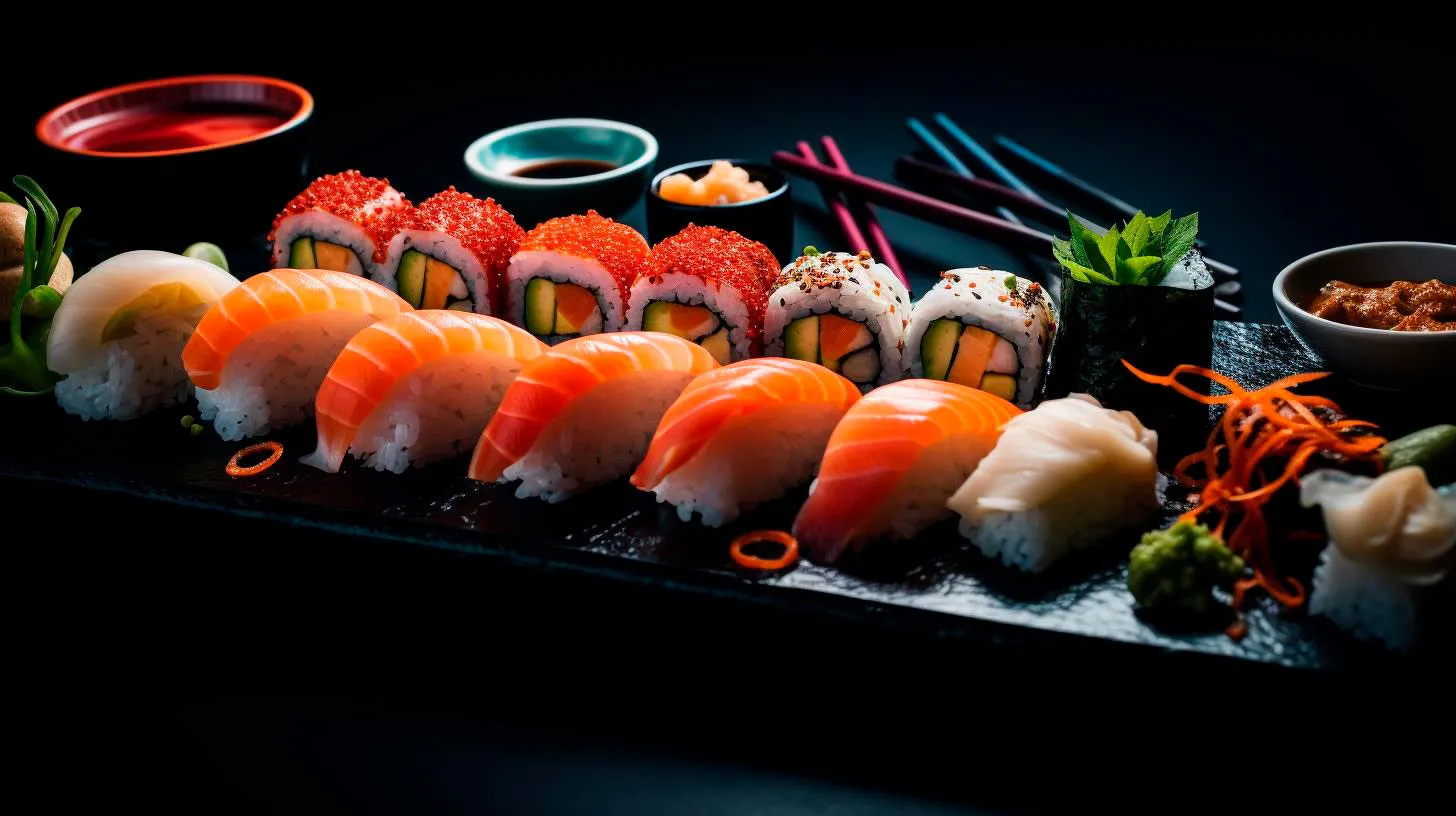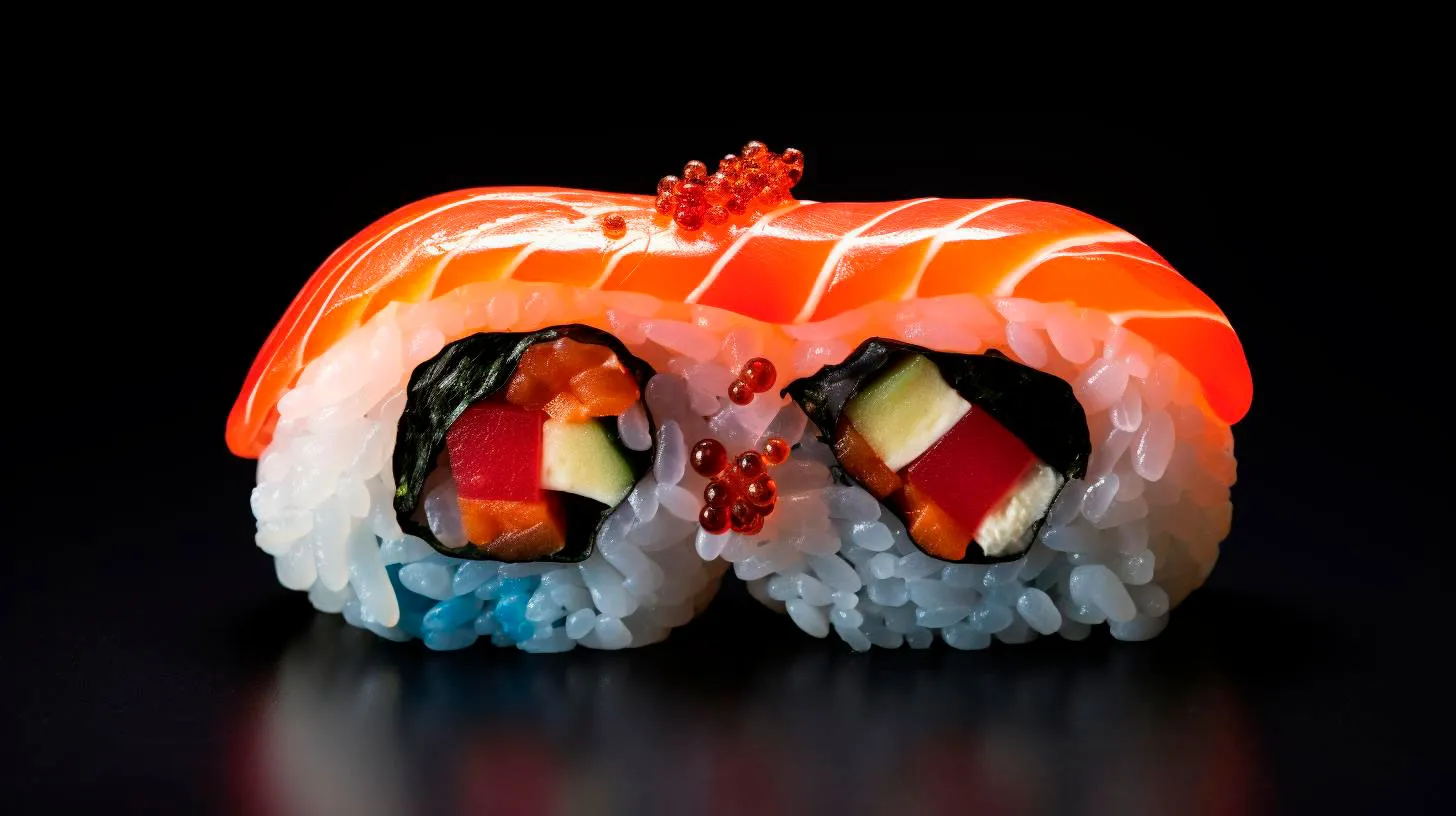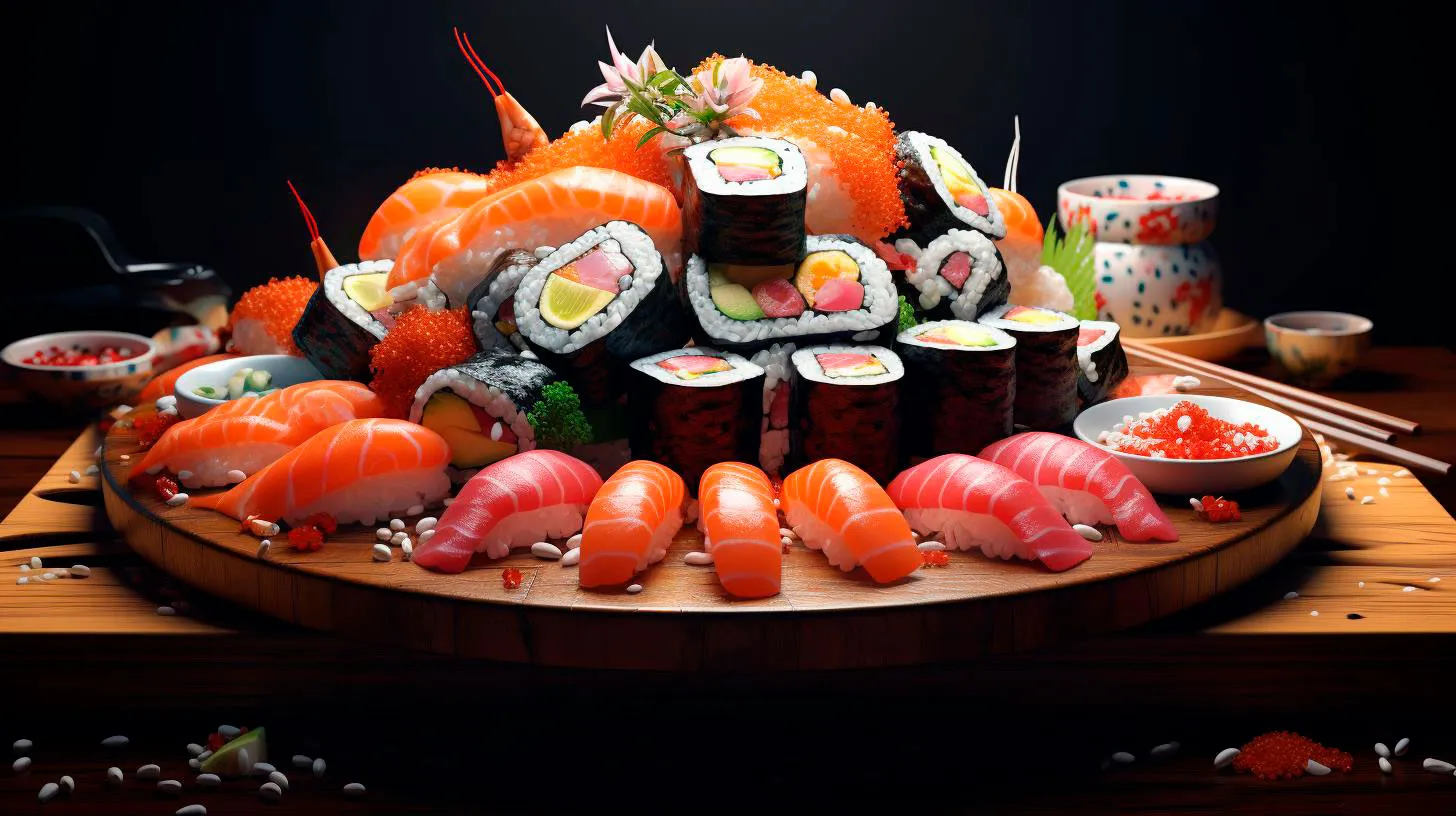Exploring the Cultural Significance of Sushi and Sake Union
In this article, we will dive into the cultural significance of the union between sushi and sake, exploring their history, craftsmanship, and the art of pairing them.
A Brief History
To truly understand the cultural significance of sushi and sake, it is essential to delve into their histories. Sushi, originating in Southeast Asia over 2,000 years ago, underwent various transformations before becoming the beloved dish we know today. Initially, the ancient form of sushi involved fermenting fish with rice to preserve it. However, during the Edo period (17th-19th centuries), sushi evolved into its modern form through the introduction of vinegar rice and the addition of toppings such as seafood and vegetables.
Similarly, sake, often referred to as rice wine, has a long history that dates back over 1,000 years. Considered Japan’s national drink, sake’s origin can be traced to the Nara period (8th century). Since then, it has evolved in terms of production techniques and taste, becoming an integral part of traditional Japanese ceremonies and celebrations.
The Craftsmanship
Both sushi and sake require meticulous craftsmanship, making their union a testament to Japanese dedication to precision and artistry. Let’s explore the craftsmanship of each individually:
Sushi Craftsmanship
Sushi chefs, known as itamae, undergo years of training to master the art of sushi-making. From sourcing the freshest ingredients to mastering the technique of slicing fish, each step requires attention to detail. The culmination of these skills results in beautifully crafted sushi pieces that not only look appealing but also deliver an extraordinary taste experience.
Key Takeaways:
- The art of sushi-making requires years of training and attention to detail.
- High-quality ingredients are essential to create exquisite sushi pieces.
- Presentation plays a crucial role in the overall sushi experience.
Sake Craftsmanship
Creating sake involves a delicate balance between tradition and innovation. Sake brewers, known as toji, carefully select the best rice grains and meticulously control the fermentation process. Each step, from washing and steaming the rice to fermenting and aging the liquid, contributes to the unique flavors and aromas found in different types of sake. The craftsmanship involved in sake production demonstrates the intricate relationship between nature, tradition, and human expertise.
Key Takeaways:
- Traditional sake brewing techniques are preserved while incorporating modern innovations.
- Rice quality and fermentation process are key factors in sake production.
- Sake aging enhances the flavors and complexities of the final product.
The Art of Pairing
Pairing sushi and sake is an art form in itself, wherein the flavors of both complement and enhance one another. The right combination can elevate the entire dining experience, evoking a sense of harmony between the food and the drink. Here are some key considerations when pairing sushi and sake:
- Fatty fish, such as salmon or tuna, pairs well with rich, full-bodied sake.
- Light and delicate sushi, like white fish or vegetable rolls, harmonize with dry and crisp sakes.
- Consider regional pairings, for example, trying a sushi roll with a sake from the same region in Japan.
Key Takeaways:
- Pairing sushi and sake involves finding a balance in flavors and textures.
- Experimentation and personal preference are encouraged to discover unique combinations.
- Understanding the characteristics of different sakes and sushi types is crucial for successful pairings.
Cultural Symbolism
Sushi and sake not only represent exceptional culinary delights but also symbolize various cultural concepts in Japan:
- Simplicity: Sushi embodies the Japanese concept of simplicity, where each ingredient is purposefully chosen to create harmony and balance on the plate.
- Respect for Tradition: Both sushi and sake production honor centuries-old traditions, maintaining a profound sense of respect for their cultural heritage.
- Attention to Detail: The craftsmanship involved in making sushi and sake reflects the meticulousness and precision deeply ingrained in Japanese culture.
In conclusion, the union between sushi and sake goes beyond a mere combination of flavors; it encapsulates the essence of Japanese culture. Exploring their histories, craftsmanship, art of pairing, and cultural symbolism enhances our understanding and appreciation for these iconic Japanese delicacies. So, next time you indulge in sushi accompanied by a glass of sake, take a moment to savor the cultural significance within each bite and sip.
Unveiling the Art of Sushi and Sake Harmony
As sushi enthusiasts, we understand the importance of finding the perfect pairing to elevate your dining experience. Join us as we explore the art of sushi and sake harmony, discover the different types of sake, and uncover the secrets of creating a symphony of flavors.
The Essence of Sushi and Sake Pairings
When it comes to sushi and sake pairings, the goal is to create a harmonious balance between the flavors of both. The right sake can enhance the flavors of the sushi, bringing out its natural sweetness, umami, and acidity. Similarly, the umami-rich elements of sushi can complement the unique characteristics of sake.
Types of Sake
Before diving into the art of pairing sushi with sake, it is essential to understand the different types of sake available:
- Junmai: This type of sake is made purely from rice and water. It has a rich and full-bodied flavor, with a hint of fruitiness.
- Ginjo: Ginjo sake is highly aromatic, with a light and crisp taste. It is made using a special fermentation process that involves milling the rice to remove impurities.
- Daiginjo: Daiginjo sake is the pinnacle of sake brewing. It goes through an extensive milling process, resulting in a refined and delicate flavor profile.
- Nigori: Unlike other types of sake, nigori is unfiltered, giving it a cloudy appearance. It has a sweet and creamy texture, making it an excellent choice for those who prefer a richer sake experience.
Pairing Sushi with Sake
Pairing sushi with sake is an art form in itself. Here are some expert tips to help you find the perfect combination:
- Consider the flavors: Take note of the flavors in your sushi. For example, delicate fish like white tuna pairs well with a light and aromatic ginjo sake.
- Match intensity: Make sure the intensity of the sake matches the intensity of the sushi. Fatty and rich fish, such as salmon, pairs well with a full-bodied junmai sake.
- Explore contrasting flavors: Sometimes, contrasting flavors can create a delightful pairing. Try pairing a rich nigiri sushi with a clean and crisp daiginjo sake to experience a harmonious contrast.
The Benefits of Sushi and Sake Pairings
The art of sushi and sake harmony extends beyond the flavors on your palate. Here are some of the benefits of pairing these two iconic Japanese staples:
- Enhanced flavors: When sushi and sake are paired thoughtfully, the flavors of both are elevated, creating a truly memorable dining experience.
- Expanding your palate: Exploring sushi and sake pairings allows you to expand your palate and discover new tastes and textures.
- Cultural appreciation: By delving into the art of sushi and sake harmony, you gain a deeper understanding and appreciation for Japanese culture and traditions.
Now that you’ve uncovered the secrets of the art of sushi and sake harmony, embark on your own culinary journey. Find the perfect sake to complement your favorite sushi and elevate your dining experience. Cheers to a harmonious union of flavors!
Disclaimer: This blog article does not provide any medical or dietary advice. Please drink responsibly and consult with a healthcare professional if you have any concerns.
Pro Tips for Pairing Sushi and Sake Flawlessly
In this blog post, we’ll provide you with pro tips on how to flawlessly pair sushi and sake, ensuring a gastronomic adventure you won’t soon forget.
Understanding the Basics
Before we delve into the art of pairing sushi and sake, it’s essential to understand the basics of each element. Sushi, typically made from vinegared rice combined with various ingredients like raw or cooked fish, vegetables, and seaweed, embodies a delicate balance of flavors and textures. On the other hand, sake, with its diverse range of flavors and aromas, complements sushi by enhancing its taste profiles and cleansing the palate between bites.
The Perfect Sushi and Sake Pairings
Now, let’s explore some pro tips for pairing sushi and sake flawlessly:
1. Consider the Fish
- Rich, fatty fish like salmon or tuna pairs well with fuller-bodied sakes.
- Light fish such as flounder or snapper harmonize with lighter and drier sakes.
2. Match Intensity
- Milder sushi flavors, like cucumber or avocado rolls, pair wonderfully with delicate and dry sakes.
- Stronger flavors, like spicy tuna rolls, call for bold and fuller-bodied sakes.
3. Consider the Texture
- For sushi with a soft texture, like uni (sea urchin) or tamago (egg), delicate and slightly sweet sakes are excellent choices.
- Crispy sushi options, such as tempura rolls, are elevated when paired with sparkling and effervescent sakes.
4. Regional Pairings
- Pairing sushi from different regions of Japan with sakes brewed in the same area creates a harmonious fusion of flavors.
- Try matching nigiri sushi from Hokkaido with a sake from the same region for an authentic culinary experience.
5. Temperature Matters
- Sake can be served chilled, at room temperature, or even warm, depending on the type and personal preference.
- Lighter sakes are often best enjoyed chilled, while richer and robust sakes may be served slightly warmed.
Key Takeaways
Pairing sushi and sake flawlessly requires careful consideration of the flavors, textures, and regional origins of both elements. Remember these key takeaways:
- Matching the richness of the fish with the body of the sake is crucial.
- Consider the intensity of flavors in both the sushi and the sake for a harmonious pairing.
- Factor in the texture of the sushi to find a complementary sake.
- Exploring regional pairings offers a unique and authentic experience.
- Don’t forget about serving sake at the appropriate temperature to enhance the tasting experience.
Now that you’re equipped with these pro tips, venture into the world of sushi and sake pairings confidently. Discover the myriad of flavors and sensations that emerge when these two Japanese treasures come together. Explore, experiment, and enjoy the remarkable combination of sushi and sake, and elevate your gastronomic adventures to a new level.
Savoring the Symphony of Flavors in Sushi and Sake Fusion
Join us on a gastronomic journey as we explore the art of sushi and sake fusion, and discover the delightful symphony of flavors that awaits.
Fusion of Tradition and Creativity
Sushi, with its origins dating back centuries in Japan, has evolved into an art form that blends tradition with innovation. Traditional sushi focuses on fresh, premium ingredients showcased in nigiri, where a piece of thinly sliced fish rests atop a small mound of vinegared rice. However, sushi chefs around the world have embraced creativity, pushing the boundaries by introducing new elements and flavor combinations.
When it comes to sushi fusion, the possibilities are endless. From fusion rolls featuring avocado, spicy mayo, and tempura flakes to incorporating unexpected ingredients like truffle oil or foie gras, sushi chefs continuously experiment with new flavors and techniques. This fusion approach allows for a diverse menu catering to a range of palates, giving customers a unique and memorable dining experience.
The Perfect Pairing – Sushi and Sake
No culinary harmony is as delightful as the pairing of sushi and sake. Sake, brewed from polished rice, is renowned for its delicate flavors and smoothness. Just as sushi showcases a variety of textures and flavors, sake brings a symphony of taste to the table. The balance and complexity of sake complement the freshness of sushi, elevating the dining experience.
When deciding which sake to pair with sushi, it’s essential to consider the characteristics of both components. Light, crisp sakes complement delicate fish, allowing their flavors to shine. Richer, fuller-bodied sakes are perfect for heartier dishes or sushi rolls with bolder ingredients. By exploring different styles of sake, one can unlock an array of flavors, enhancing the dining experience with each sip.
Key Takeaways
- Sushi fusion celebrates tradition while introducing innovative flavor combinations.
- Experimentation with new ingredients creates unique and memorable dining experiences.
- Sake enhances the flavors of sushi, creating a harmonious taste experience.
- Pairing sushi and sake offers a diverse range of flavors and textures.
- Different styles of sake can be paired with specific sushi dishes for optimal taste.
Embrace the Flavors and Experience
As sushi and sake continue to captivate the taste buds of food enthusiasts worldwide, the fusion of these culinary treasures opens up a realm of endless possibilities. Whether you prefer traditional nigiri or exciting fusion rolls, the pairing of sushi and sake ensures a dining experience that is not only delicious but also an exploration of flavors.
Next time you indulge in the art of sushi and sake fusion, take a moment to savor the symphony of flavors. Let the delicate fish, perfectly seasoned rice, and smoothness of sake dance on your palate, reminding you of the harmony that exists when art and taste intertwine.



